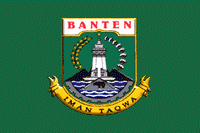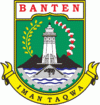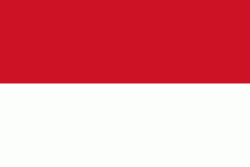Banten
 |
 |
Present-day Banten was part of the Sundanese Tarumanagara kingdom from the fourth to the seventh centuries AD. After the fall of Tarumanegara, it was controlled by Hindu-Buddhist kingdoms such as the Srivijaya Empire and the Sunda Kingdom. The spread of Islam in the region began in the 15th century; by the late 16th century, Islam had replaced Hinduism and Buddhism as the dominant religion in the province, with the establishment of the Banten Sultanate. European traders began arriving in the region – first the Portuguese, followed by the British and the Dutch. The Dutch East India Company (VOC) finally controlled the regional economy, gradually weakening the Banten Sultanate. On 22 November 1808, Dutch Governor-General Herman Willem Daendels declared that the Sultanate of Banten had been absorbed into the Dutch East Indies. This began the Bantam Residency, 150 years of direct Dutch rule. In March 1942, the Japanese invaded the Indies and occupied the region for three years before their August 1945 surrender. The region was returned to Dutch control for the next five years before the Dutch left and it was ruled by the Indonesian government. Banten then became part of the province of West Java, and separatist efforts led to the creation of the province of Banten in 2000.
Banten is diverse, inhabited by many ethnic groups; the most dominant is the Bantenese people. The Sundanese language is the province's lingua franca, although Indonesian is the official language. Javanese is also spoken by many Javanese migrants from Central and East Java. The semi-isolated Baduy people, who speak the Baduy language (an archaic form of Sundanese), live in the Lebak Regency. Most of the population is fluent in Indonesian as a second language.
The name "Banten" has several possible origins. The first is from the Sundanese phrase katiban inten, which means "struck down by diamonds". The phrase comes from the history of the Bantenese people, who were animists before adopting Buddhism and Hinduism. After Islam began to spread in Banten, the community began to recognize and embrace Islam. The spread of Islam in Banten is described as being "struck down by diamonds".
Another origin story is that the Indonesian Hindu god Batara Guru traveled from east to west, arriving at Surasowan (present-day Serang). When he arrived, Batara Guru sat on a stone which became known as watu gilang. The stone glowed, and was presented to the king of Surasowan. Surasowan was reportedly surrounded by a clear, star-like river, and was described as a ring covered with diamonds (Sundanese: ban inten). This evolved into "banten".
Another possibility is that "Banten" comes from the Indonesian word bantahan (rebuttal), because the local Bantenese people resisted the Dutch colonial government. The word "Banten" appeared before the establishment of the Banten Sultanate as the name of a river. The high plains on its banks were called Cibanten Girang, shortened to Banten Girang (Upper Banten). Based on research in Banten Girang, the area has been settled since the 11th and 12th centuries. During the 16th century, the region developed rapidly towards Serang and the northern coast. The coastal area later became the Sultanate of Banten, founded by Sunan Gunung Jati, which controlled almost all of the former Sunda Kingdom in West Java. Sunda Kelapa (Batavia) was captured by the Dutch, and Cirebon and the Parahiyangan region were captured by the Mataram Sultanate. The Banten Sultanate was later converted into a residency by the Dutch.
Map - Banten
Map
Country - Indonesia
 |
 |
| Flag of Indonesia | |
As the world's third largest democracy, Indonesia is a presidential republic with an elected legislature. It has 38 provinces, of which nine have special status. The country's capital, Jakarta, is the world's second-most populous urban area. Indonesia shares land borders with Papua New Guinea, East Timor, and the eastern part of Malaysia, as well as maritime borders with Singapore, Vietnam, Thailand, the Philippines, Australia, Palau, and India. Despite its large population and densely populated regions, Indonesia has vast areas of wilderness that support one of the world's highest level of biodiversity.
Currency / Language
| ISO | Currency | Symbol | Significant figures |
|---|---|---|---|
| IDR | Indonesian rupiah | Rp | 2 |
| ISO | Language |
|---|---|
| NL | Dutch language |
| EN | English language |
| ID | Indonesian language |
| JV | Javanese language |


















